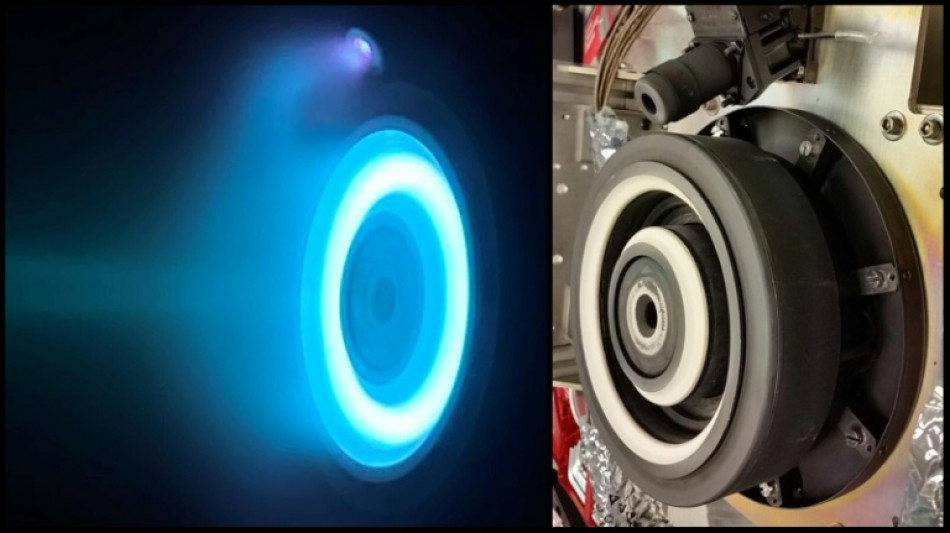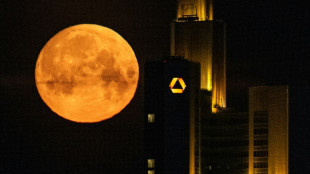
-
 Putin evokes WWII victory to rally Russia behind Ukraine offensive
Putin evokes WWII victory to rally Russia behind Ukraine offensive
-
China exports beat forecasts ahead of US tariff talks

-
 Leo XIV, the 'Latin Yankee', to celebrate first mass as pope
Leo XIV, the 'Latin Yankee', to celebrate first mass as pope
-
Most stocks lifted by hopes for US-China talks after UK deal

-
 IPL suspended indefinitely over India-Pakistan conflict: reports
IPL suspended indefinitely over India-Pakistan conflict: reports
-
German lender Commerzbank's profits jump as it fends off UniCredit

-
 Rare bone-eroding disease ruining lives in Kenya's poorest county
Rare bone-eroding disease ruining lives in Kenya's poorest county
-
India says repulsed fresh Pakistan attacks as de-escalation efforts grow

-
 Zhao's historic snooker title sparks talk of China world domination
Zhao's historic snooker title sparks talk of China world domination
-
'High expectations': EU looks to Merz for boost in tough times

-
 Poisoned guests rarely invited before deadly mushroom lunch, Australia trial hears
Poisoned guests rarely invited before deadly mushroom lunch, Australia trial hears
-
China sales to US slump even as exports beat forecasts

-
 Indian cricket to make 'final decision' on IPL over Pakistan conflict
Indian cricket to make 'final decision' on IPL over Pakistan conflict
-
Dethroned Bundesliga champions Leverkusen face uncertain future

-
 China can play hardball at looming trade talks with US: analysts
China can play hardball at looming trade talks with US: analysts
-
French monuments in trouble while PSG prepare for Champions League final

-
 Newcastle face Chelsea in top five showdown, Alexander-Arnold in spotlight
Newcastle face Chelsea in top five showdown, Alexander-Arnold in spotlight
-
Flick's Barca must show 'hunger' in crunch Liga Clasico

-
 Clasico the last chance saloon for Ancelotti's Real Madrid
Clasico the last chance saloon for Ancelotti's Real Madrid
-
Timberwolves overpower Warriors to level series

-
 Chinese fabric exporters anxious for US trade patch-up
Chinese fabric exporters anxious for US trade patch-up
-
Putin gears up to host world leaders at lavish army parade

-
 Nearing 100, Malaysian ex-PM Mahathir blasts 'old world' Trump
Nearing 100, Malaysian ex-PM Mahathir blasts 'old world' Trump
-
Leo XIV, first US pope, to celebrate first mass as pontiff

-
 Asian stocks lifted by hopes for US-China talks after UK deal
Asian stocks lifted by hopes for US-China talks after UK deal
-
Former head of crypto platform Celsius sentenced 12 years

-
 Ex-model testifies in NY court that Weinstein assaulted her at 16
Ex-model testifies in NY court that Weinstein assaulted her at 16
-
Nestlé and OMP Showcase Approach to Future-Ready Supply Chain at Gartner Supply Chain Symposium/Xpo in Barcelona

-
 Genflow Biosciences PLC Announces Share Subscription, Director's Dealing and Update
Genflow Biosciences PLC Announces Share Subscription, Director's Dealing and Update
-
Argo Blockchain PLC Announces 2024 Annual Results and Restoration of Listing

-
 'Great honor': world leaders welcome first US pope
'Great honor': world leaders welcome first US pope
-
Pacquiao to un-retire and fight Barrios for welterweight title: report

-
 Trump unveils UK trade deal, first since tariff blitz
Trump unveils UK trade deal, first since tariff blitz
-
Man Utd one step away from Europa League glory despite horror season

-
 Jeeno shines on greens to grab LPGA lead at Liberty National
Jeeno shines on greens to grab LPGA lead at Liberty National
-
Mitchell fires PGA career-low 61 to grab Truist lead

-
 AI tool uses selfies to predict biological age and cancer survival
AI tool uses selfies to predict biological age and cancer survival
-
Extremely online new pope unafraid to talk politics

-
 Postecoglou hits back as Spurs reach Europa League final
Postecoglou hits back as Spurs reach Europa League final
-
Chelsea ease into Conference League final against Betis

-
 Pope Leo XIV: Soft-spoken American spent decades amid poor in Peru
Pope Leo XIV: Soft-spoken American spent decades amid poor in Peru
-
First US pope shared articles critical of Trump, Vance

-
 'Inexcusable' - NBA champs Boston in trouble after letting big leads slip
'Inexcusable' - NBA champs Boston in trouble after letting big leads slip
-
US automakers blast Trump's UK trade deal

-
 Stocks mostly rise as US-UK unveil trade deal
Stocks mostly rise as US-UK unveil trade deal
-
Trump presses Russia for unconditional 30-day Ukraine ceasefire

-
 Anything but Europa League glory 'means nothing' for Man Utd: Amorim
Anything but Europa League glory 'means nothing' for Man Utd: Amorim
-
'Inexcuseable' - NBA champs Boston in trouble after letting big leads slip

-
 Pope Leo 'fell in love with Peru'and ceviche: Peru bishop
Pope Leo 'fell in love with Peru'and ceviche: Peru bishop
-
Pakistan's T20 cricket league moved to UAE over India conflict


Five things to know about NASA's mission to a metal world
For the first time ever, a NASA probe is set to journey to an object composed not of rock, ice, or gas, but metal: the asteroid Psyche.
By studying this space oddity, scientists hope to learn more about the inner cores of rocky planets such as our own -- or, potentially catalog a previously unknown class of cosmic body.
Here are some big numbers and fun facts to dazzle your friends with about the mission.
- $10 quadrillion -
If Psyche were mineable, its iron, nickel and gold deposits could be worth an eye-watering $10,000 quadrillion (that's $10,000,000,000,000,000,000), according to an estimate reported by Forbes magazine.
But Lindy Elkins-Tanton, the mission's principal investigator who was responsible for that calculation, said it's nothing more than a "fun intellectual exercise with no truth to it."
"We have zero technology as a species to bring Psyche back to Earth," she said in a recent briefing. Attempting to do so could backfire by causing an apocalyptic collision -- but even if the endeavor were successful, it would flood the metals market, reducing their value to zero, she said.
- An electric voyage -
The Psyche probe will blast off on a SpaceX Falcon Heavy rocket, but to complete its 2.2 billion-mile (3.6 billion-kilometer) journey, it will turn to a far more efficient form of propulsion.
Psyche's solar arrays convert light into electricity, providing the power for its four solar electric or "Hall-effect" thrusters. These use electromagnetic fields to accelerate and expel ions (charged atoms) of xenon, the same inert gas used in car headlights and plasma TVs.
While the resulting blue glow is evocative of Star Trek, it's no warp drive: the actual force it exerts in a given moment is roughly equal to the weight of an AA battery in the palm of your hand.
But in the void of space, the probe will accelerate continuously to tens of thousands of miles an hour.
- Laser communications -
With deep space missions demanding higher and higher data rates, NASA is turning to laser-based systems to complement radio-frequency based communications.
Psyche will carry onboard a technology experiment, to demonstrate a "10 times augmentation of traditional telecom data rates," said Abi Biswas of NASA's Jet Propulsion Laboratory -- enabling the transmission of higher resolution images, more science data, and streaming video.
NASA will shoot its laser beam from a JPL facility on Table Mountain in California, with the spacecraft firing its signal back to Caltech's Palomar Observatory. The hope is eventually to use the technology on human missions to Mars.
- Gravity science -
Psyche has a suite of dedicated scientific instruments to probe the asteroid's chemical and mineral composition and look for signs of an ancient magnetic field.
But the science team will also use Psyche's trusty old radio system to probe the asteroid's gravity field using the Doppler Effect.
"We can look at the pitch or frequency of the radio waves coming from the antenna and figure out how fast the spacecraft is moving" as it orbits its target, said planetary scientist Ben Weiss, just as ambulance sirens have a higher pitch as they come towards you and lower as they move away.
By tracking the spacecraft's speed at different points around the asteroid, they can determine how "lumpy" the gravity field is, which in turn provides clues about the composition and structure of the interior.
- Less metal, more rock? -
Given its brightness, there was until recently broad consensus that Psyche was almost entirely metal -- consistent with the theory it is an exposed planetary core whose rocky crust and mantle were blown off in an ancient collision.
But the way it imposes gravity on neighboring bodies suggests it's less dense than all iron-body should be, according to a 2022 paper by researchers at Brown University.
One possibility they put forward is iron-spewing volcanoes brought metal up from Psyche's core to coat its surface above a rocky mantle -- effectively creating a structure akin to a metal sandwich.
It won't be until 2029, when the Psyche spacecraft reaches its destination, that we'll know for sure.
F.Dubois--AMWN

